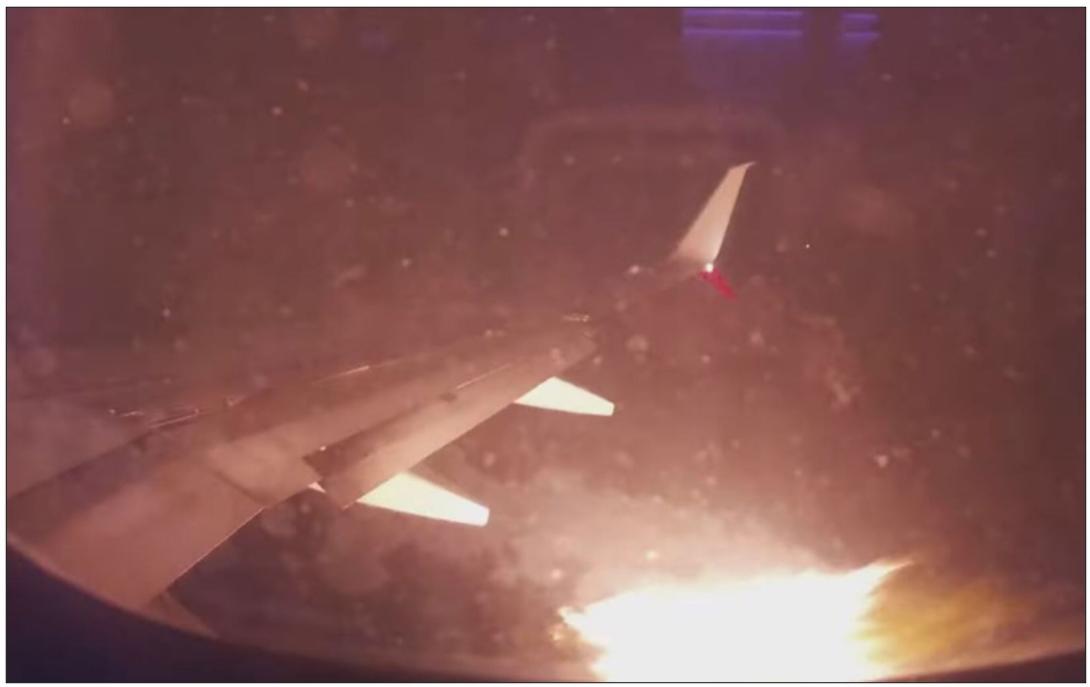| Occurrence Briefs are concise reports that detail the facts surrounding a transport safety occurrence, as received in the initial notification and any follow-up enquiries. They provide an opportunity to share safety messages in the absence of an investigation. Because occurrence briefs are not investigations under the Transport Safety Investigation Act 2003, the information in them is de-identified. |
What happened
Shortly after departure from Queenstown, New Zealand, at about 1800 local time on 17 June 2024, a Boeing 737-8FE aircraft, carrying 67 passengers and 6 crew, en route to Melbourne, Victoria, was observed with flames emanating from the number 2 engine (Figure 1). The flight crew, responding to instrumentation indicating engine damage, shut down the affected engine and diverted to Invercargill, New Zealand where the aircraft landed safely.
A subsequent maintenance inspection of the aircraft indicated evidence of a birdstrike. It was reported that one bird, believed to be a duck, had been ingested into the number 2 engine and a second duck had struck the aircraft. This caused substantial damage to the fan blade, this damage, coupled with the engine surging, required the engine to be replaced.
Figure 1: Photograph of fire emanating from engine of Boeing 737-8FE aircraft

Source: Channel 9 news.com
Safety message
Occurrences involving aircraft striking wildlife, particularly birds, continue to be the most common aviation occurrence reported to the ATSB. Birdstrikes are a potential safety risk to aircraft and aerodrome operators.
The ATSB has recently launched a new dedicated aviation wildlife strike occurrence dashboard, which aims to provide valuable information to pilots, aerodrome operators, aircraft operators, aviation regulators and other industry participants, to assist with understanding and managing the hazards associated with wildlife strikes. Importantly, the dashboard does not include any identifying information about pilots or aircraft.
Birdstrikes typically result in nil to minor damage to aircraft, and nil to minor injuries to occupants, however, severe and fatal accidents as a result of birdstrikes in small aircraft have occurred. Birdstrikes can occur during any phase of flight but are more common during the take-off and landing phases, due partly to the increased numbers of birds at lower heights. Aerodrome operators employ various measures to mitigate these occurrences and to control bird numbers, however, when a birdstrike does happen, pilots are ultimately required to deal with the consequences. This emphasises the importance of crew training and preparedness for in-flight emergencies to ensure the safety of the aircraft and its occupants. By following established procedures and prioritising effective communication, the outcomes associated with birdstrikes can be mitigated by pilots.
About this report
Decisions regarding whether to conduct an investigation, and the scope of an investigation, are based on many factors, including the level of safety benefit likely to be obtained from an investigation. For this occurrence, no investigation has been conducted and the ATSB did not verify the accuracy of the information. A brief description has been written using information supplied in the notification and any follow-up information to produce a short summary report and allow for greater industry awareness of potential safety issues and possible safety actions.


